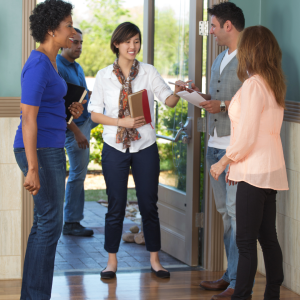 Slips, trips and falls are some of the most common injuries across industry lines, with religious organizations being no exception. In fact, the nature of these organizations’ operations—namely, experiencing frequent foot traffic on-site from community members and employees of varying ages—may contribute to an increased risk of such injuries. According to the latest industry research, more than 50% of injuries that occur in churches stem from slip, trip and fall incidents.
Slips, trips and falls are some of the most common injuries across industry lines, with religious organizations being no exception. In fact, the nature of these organizations’ operations—namely, experiencing frequent foot traffic on-site from community members and employees of varying ages—may contribute to an increased risk of such injuries. According to the latest industry research, more than 50% of injuries that occur in churches stem from slip, trip and fall incidents.Conducting Risk Assessments
Practicing Good Housekeeping
- Utilize a routine cleaning regimen to ensure all walkways are kept clear of clutter and debris. Select an employee (or group of employees) to be in charge of this regimen.
- Refrain from leaving extension cords exposed in heavily trafficked walkways, as these cords could pose tripping hazards. Be sure to cover extension cords with cord concealers and cable ties, or move them out of walkways altogether (if possible). Further, consider reaching out to a licensed electrician to discuss permanent solutions for limiting extension cord usage.
- Have a plan in place to identify and clean up spills as quickly and efficiently as possible. Designated employees should be alerted to rope off the area and remove the mess when spills occur. The affected area should stay roped off until it is completely dry.
- Conduct daily walkthroughs of the property to remedy any housekeeping needs before officially opening the doors.
Maintaining Walking Surfaces and Equipment
- Clean floors and stairs on a routine basis. Keep in mind that cleaning methods may vary between floor and stair materials.
- Inspect floors and stairs periodically for potential damages (e.g., cracked tiles or lifted wood). Perform maintenance as needed.
- Consider placing nonslip rugs in areas with uneven or slippery walking surfaces. Make sure these rugs remain flat on the ground. Clean and inspect these rugs regularly, watching for tears and curled edges. Replace damaged or worn rugs as needed.
- Inspect external walking surfaces, such as curbs, sidewalks, entry steps, ramps, patios and parking lots, for potential hazards (e.g., potholes, cracks, debris, pooling water and steep elevation changes) on a routine basis. Make repairs when necessary to keep these surfaces as smooth and level as possible.
- Equip all stairs and steps with proper handrails. These handrails should be sturdy and measure an appropriate height. Inspect these handrails periodically, performing maintenance and making replacements as needed.
- Maintain all on-site equipment (e.g., ladders, step stools, platforms and risers). Require employees and community members to inspect this equipment for damage before use. Repair and replace equipment when necessary.
Ensuring Visibility
Staying Compliant
Addressing Seasonal Hazards
- Create a snow and ice removal plan for the winter months. This plan should involve having designated, qualified employees or hired professionals shovel snow and de-ice external walking surfaces as needed.
- Establish a leaf removal plan for the autumn months. This plan should include having designated, qualified employees or hired professionals rake and dispose of fallen leaves throughout the property when necessary.
- Maintain proper landscaping across the property during the spring and summer months. This entails having designated, qualified employees or hired professionals cut the grass regularly, remove accumulations of greenery (e.g., weeds, algae and moss) from external walking surfaces and dispose of any lawn debris (e.g., grass clippings and fallen tree branches). If the property has a cemetery on-site, make sure these landscaping efforts extend to that area. Repair broken or damaged graves and headstones as needed.
- Make sure adequate supplies are available on-site for snow and ice removal, leaf removal and landscaping operations. These supplies may include shovels, salt, sand, rakes and trimmers, among others.
- Consider placing nonslip, water-resistant mats at all entryways to collect excess moisture that employees and community members may carry in on their shoes from heavy rain or snow. Keep these mats in good condition.
- Inspect all property drainage systems to ensure they aren’t causing water or ice buildup on-site. If any problems arise, consult a trusted and qualified contractor to make repairs.
- Have the roof and pipes assessed regularly to look for signs of leaking, as these leaks could lead to floor moisture and subsequent slip, trip and fall hazards. If any issues are detected, have them fixed immediately.
Utilizing Safety Signage
Conclusion
This material is for informational purposes only. It is not intended to give specific legal or risk management advice, nor are any suggested checklists or action plans intended to include or address all possible risk management exposures or solutions. You are encouraged to retain your own expert consultants and legal advisors in order to develop a risk management plan specific to your own activities.
ChurchInsure is a division of Anchor Insurance Agencies specializing in the unique insurance and risk management needs of religious institutions. Visit our website to learn how we can serve you at anchor-insurance.com/churchinsure.
© 2024 Zywave, Inc. All rights reserved


